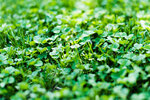


The lawn is taking a beating these days. It’s accused of all manner of environmental crimes, starting with reducing biodiversity and sucking up excessive amounts of water. Mowing it with a gas-powered mower is, by one account, responsible for five percent of our nation’s carbon emissions. Fertilizing it causes runoff that pollutes water, so do herbicides that kill off weeds. It is our largest irrigated crop; according to a 2005 NASA study, the U.S. has 63 million acres of it.
In some circles, having a lawn is becoming a cultural stigma. An article in the Guardian even claims that lawns are racist because owning a home with a lawn comes with a history of racially exclusionary redlining and racial wealth disparities. That made me wonder about people who rent a house and mow the lawn. Is their lawn racist? How about the lawns in parks that we all share?
Sweeping statements like that trivialize the very real impacts of racism and add nothing to our knowledge about lawns. Honestly, sometimes it seems that in America today, opinions on every topic get taken to jaw-dropping extremes.
After reading way too much about lawns, here’s a distillation of the available common sense:
One caveat to the tall-lawn idea: dry brown grass can be a fire hazard.
And now a digression: Years ago in Indonesia, I never saw tall grass, because wherever there was grass, there were boys tending small flocks of goats that ate it – even in the median of busy urban boulevards. A man who hired out to cut the grass in people’s yards with a scythe used it to feed the pony that pulled his cart. Grass was a resource that was never wasted.
I don’t suppose we could emulate that way of thinking about and using grass, but I do sometimes imagine sheep or goats grazing on those sweeping suburban lawns.
A gardener reported that the house she and her husband now live in had a lawn at one time, but a new owner pulled it out and planted gardens. The next owners pulled out the garden and replanted a lawn for their kids to play on. She and her husband have now pulled out that lawn and are planting gardens. The moral of that story: If you have kids, you probably want to keep your lawn. (And if you don’t have kids, maybe you have time to dig up your lawn.)
We are all free to make up our own minds about whether to have lawns, how big they are, how to manage them, and how to be at peace with our consciences. And we are all free to choose among the various points of view and conflicting data online.
Jill Severn writes from her home in Olympia, where she grows vegetables, flowers, and a small flock of chickens. She loves conversation among gardeners. Start one by emailing her at jill@theJOLTnews.com
6 comments on this item Please log in to comment by clicking here
AugieH
Try pitching unmowed, unwatered, and/or unfertilized lawns to the HOA of a large neighborhood that seeks to achieve a neat, manicured, and uniform appearance to attract new residents. Good luck with that! Why not just replace your lawn with an overgrowth of Scotch Broom; it doesn't have to be watered or tended and is a lovely yellow.
Friday, September 15, 2023 Report this
ConservativeHippie
"Mowing it with a gas-powered mower is, by one account, responsible for five percent of our nation’s carbon emissions."
Weird stat right? Well, the author misleads. The 5% statistic is inclusive of all "non-road" engines like lawn mowers.
My lawn is brown btw.
Really could have used a tip on gardening. Late stage watering is confusing. My grandfather said I should stop watering the peppers a couple weeks ago to encourage production of fruit growth versus plant growth. But I can't find any info that would support that claim.
Why does this gardening column constantly produce virtue signaling programing versus gardening tips?
Saturday, September 16, 2023 Report this
GinnyAnn
I live in one of those communities with an HOA-controlled, contracted, landscaped, front lawn patch. It does nothing except require the landscape company's maintenance. I put in my personal request to forbid chemical use since I realized that I had no bugs or other living creatures in my garden. Now I'm seeing lovely bugs returning even though I do have weeds in my lawn. I do want to comment to AugieH who would plant Scotch broom. OMG! This is an invasive species that no one can eradicate. This is a scourge in our state that many are highly allergic to and most of us hate mightily. You can't kill it. There are hybrids to plant in a garden now, but the wild, invasive broom forces out all native species and destroys habitat. Nothing eats it except gnats, as far as I can tell. So what if it's yellow? So are yellow jackets, but I don't want them in my yard.
Saturday, September 16, 2023 Report this
KarenM
Some HOA Boards are made up of volunteers from the residents. If you live in a HOA neighborhood you could potentially change the traditions to a more natural and sustainable approach. The noise and pollution from gas powered mowers is not the only problem. The workers are exposed to fumes, bad air and gas as well as high noise levels. Home owners should be allowed to establish native plants and keep them up to avoid the lawn.
Saturday, September 16, 2023 Report this
Terrilovesanimals
I'm with Conservative Hippie. 5%??? I don't think so. And noise? Just try and hear a lawnmower over the freeway or motorcycles/noisy cars and trucks down our streets. Taking care of lawns gets people off of their butts and outside too!
Sunday, September 17, 2023 Report this
MrMonk
Since climate has been falsely defined by most of the "scientific" world, it is no wonder so many bad ideas are earning so much money.
Lawns are good.
Atmospheric carbon dioxide is VERY good, and we should be attempting to build the level of CO2 up to about 1500 parts-per-million (ppm) from the scan 410 or so ppm it is currently.
Because more CO2 is free fertilizer.
More CO2 means a much healthier biosphere as we gain trees and land plants.
Wednesday, September 20, 2023 Report this